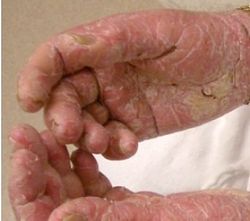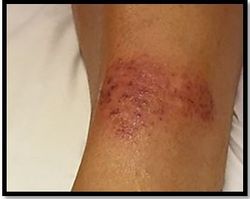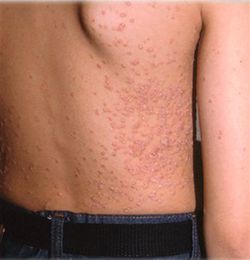© 2024 MJH Life Sciences™ and Patient Care Online. All rights reserved.
Do You Know Your Nevi? Part 3
A 32-year-old woman, who recently gave birth, seeks evaluation of 2 lesions onher neck. A linear, medium brown, warty, 4-cm lesion has been present sinceshe was born; there has been no disproportionate growth or change in color.The crusted 0.5-cm nodule at the most cephalad aspect of the linear lesiondeveloped in early pregnancy and has gradually enlarged.
Case 1:
A 32-year-old woman, who recently gave birth, seeks evaluation of 2 lesions onher neck. A linear, medium brown, warty, 4-cm lesion has been present sinceshe was born; there has been no disproportionate growth or change in color.The crusted 0.5-cm nodule at the most cephalad aspect of the linear lesiondeveloped in early pregnancy and has gradually enlarged.What course of action do you pursue?
Case 1:
Both lesions were removed by shave excision followedby electrodesiccation. Histopathologic examinationrevealed that the lesion was a
linear epidermal nevus;
the crusted lesion was a
keratoacanthoma.
A keratoacanthoma is a benign epithelial tumor thatis considered a variant of squamous cell carcinoma.These lesions may rapidly expand and crust; however,this patient's keratoacanthoma was present for 6 monthsand had not progressed. Although they may regressspontaneously, treatment, such as surgical excision, isusually recommended.Linear epidermal nevi are developmental malformations,or hamartomas, of the epidermis. Their variouspresentations include single or multiple warty brown orpale plaques, linear or zosteriform lesions, and a slightlyscaly area of discoloration. Most commonly, they appearon the head, neck, and extremities, although they maybe widespread. The lesions are present at birth or developin infancy or early childhood; they rarely progressafter adolescence.Various names are applied to these lesions accordingto the clinical presentation. Linear epidermal nevus, ornevus unius lateris, is the linear, unilateral, wartlike lesionseen in this patient. The systematized type of linear epidermalnevus features multiple linear lesions, often in aparallel arrangement on the trunk. They can be unilateralor bilateral. Ichthyosis hystrix is a bilateral irregular truncalnevus that is often disfiguring.Epidermal nevus syndrome is the occurrence of alinear epidermal nevus, usually a systematized widespreadepidermal nevus, associated with systemic anomalies;most commonly, the skeletal, neurologic, and ocular systemsare involved. The syndrome's cause is unknown.Symptoms include epilepsy, mental retardation, cataracts,kyphoscoliosis, limb hypertrophy, cutaneous hemangiomas,and systemic cancers.The differential diagnosis of linear epidermal nevusincludes nevus sebaceus, nevus comedonicus, lichenstriatus, linear lichen planus, and linear psoriasis.Treatment of a linear epidermal nevus is not requiredbut may be sought for cosmesis. Topical 5-fluorouracil andtretinoin cream can be effective. Excision or destructionof the skin down to the subcutaneous tissue is necessaryto minimize the risk of recurrence; however, even whenthis is done, recurrence is common.
FOR MORE INFORMATION:
- Habif TP. Clinical Dermatology: A Color Guide to Diagnosis and Therapy. 3rd ed.St Louis: Mosby; 1996:640-641.
- McGovern TW. Dermatology DX, case 1: a line of warty growths. CortlandtForum. 2001:31-32.
- Weedon D. Skin Pathology. London: Churchill Livingstone; 1997:635-637.
(Case and photograph courtesy of Robert P. Blereau, MD, and Pete Pecot, MD.)
Case 2:
A 31-year-old man complains thatthe lesion on his right upper back becomesirritated when he bathes. The0.5-cm, dark brown, dome-shapednodule with some tan coloration hasbeen present for as long as he canremember.Do you recognize this variant ofa common lesion?
Case 2:
The lesion was excised in the office; histopathologicexamination revealed a
polypoid compound nevus.
Compound melanocytic nevi are common in childrenand adults. Clinically, they can present as minimally elevatedto dome-shaped or polypoid, tan or dark brown lesions.Histologically, there are nests of nevus cells both atthe dermoepidermal junction (junctional component) andwithin the dermis (intradermal component). They mayhave a seborrheic keratosis-like appearance that occasionallyfeatures horn cysts. Malignant melanoma canoccur within any melanocytic nevus, including compoundnevi, but its occurrence is rare.
FOR MORE INFORMATION:
- Weedon D. Skin Pathology. 2nd ed. London: Churchill Livingstone; 2002:807.
(Case and photograph courtesy of Robert P. Blereau, MD.)
Case 3:
The parents of a 12-year-old girl areconcerned about a "birthmark" ontheir daughter's scalp that has slightlyenlarged over time. The child'smedical history is unremarkable.Is biopsy warranted?
Case 3: Nevus sebaceus of Jadassohn
is a hamartomaof the epidermis. At birth, it appears as an orange-yellowplaque on the scalp; solitary or multiple lesions that followBlaschko lines-which define the developmental growthpattern of the skin-may be present.
1
These nevi are rarelyassociated with other congenital abnormalities. The diagnosisof nevus sebaceus is usually made on clinical grounds;however, if in doubt, perform a biopsy for confirmation.These lesions grow at the same pace as the patient;typically, they become more mamillated at puberty. Astime progresses, the surface may become increasinglypapillated and even verrucous. In patients with a nevus sebaceusof Jadassohn, a small risk exists for the developmentof malignant tumors, usually basal cell carcinomas,within the nevus.Because of the risk of malignant transformation,surgical excision is recommended. This patient's nevussebaceus was excised without complications.
REFERENCE:
1.
Habif TP.
Clinical Dermatology: A Color Guide to Diagnosis and Therapy.
3rd ed. St Louis: Mosby; 1996:640-641.
(Case and photograph courtesy of Charles E. Crutchfield III, MD,and Ann A. Choi, BA.)
Case 4:
A 15-year-old girl presents for evaluationand treatment of a dark-coloredlesion that has been present on thethigh since birth. Hair is growingout of the lesion.Is it likely that this lesion ismalignant?
Case 4:
A congenital hairy nevus isa common birthmark that occurs inapproximately 1% of newborns.
1
Theselesions are larger than acquired neviand are often hypertrichotic.Controversy exists concerningthe risk of the development of malignantmelanoma within these nevi.Giant congenital nevi, which are definedby some experts as larger than20 cm, are associated with a low butreal risk of melanoma. These largernevi may be difficult to excise; theyoften require "staged excisions," inwhich a small part is removed duringeach of 2 or 3 operations, spacedseveral months apart. This operativetechnique minimizes scarring.Generally, an oval nevus needsto be excised in a fusiform manner,with the final excision length 3 timesthe diameter of the original lesion. In a staged excision,the remaining scar often approximates the diameter of theoriginal lesion. Occasionally, balloon expansion is usedto minimize scarring. Another approach is to use clinicalphotography to monitor the nevus closely for changes.This nevus was removed by staged excision. The patient'srecovery was uneventful.
REFERENCE:
1.
Ackerman AB, Kerl H, Sanchez J.
A Clinical Atlas of 101 Common SkinDiseases: With Histopathologic Correlation.
New York: Ardor Scribendi; 2000.
(Case and photograph courtesy of Charles E. Crutchfield III, MD.)



